Isis › Silver in Antiquity » Ancient origins
Articles and Definitions › Contents
- Isis › Who Was
- Silver in Antiquity › Antique Origins
Ancient civilizations › Historical and archaeological sites
Isis › Who Was
Definition and Origins
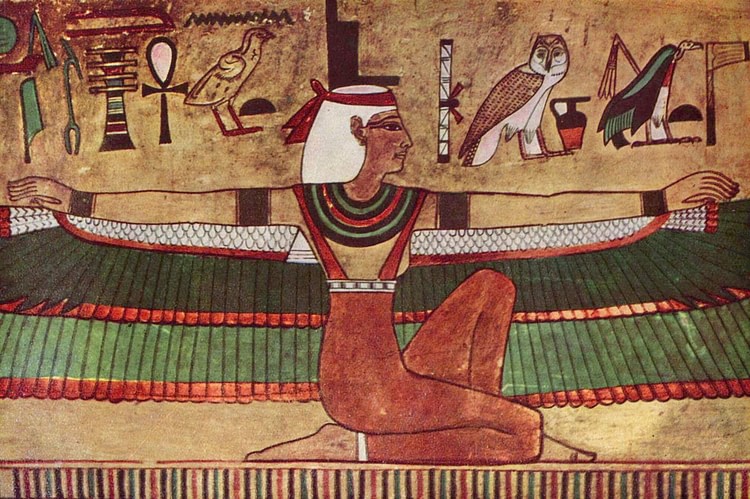
Isis is an ancient Egyptian goddess, associated with the earlier goddess Hathor, who became the most popular and enduring of all the Egyptian deities. Her name comes from the Egyptian Eset, ("the seat") which referred to her stability and also the throne of Egypt as she was considered the mother of every pharaoh through the king's association with Horus, Isis' son. Her name has also been interpreted as Queen of the Throne, and her original headdress was the empty throne of her murdered husband Osiris. Her symbols are the scorpion (who kept her safe when she was in hiding), the kite (a kind of falcon whose shape she assumed in bringing her husband back to life), the empty throne, and the sistrum. She is regularly portrayed as the selfless, giving, mother, wife, and protectress, who places other's interests and well-being ahead of her own. She was also known as Weret-Kekau ("the Great Magic") for her power and Mut-Netjer, "Mother of the Gods" but was known by many names depending on which role she was fulfilling at the moment. As the goddess who brought the yearly inundation of the Nilewhich fertilized the land she was Sati, for example, and as the goddess who created and preserved life she was Ankhet, and so on.
In time, she became so popular that all gods were considered mere aspects of Isis and she was the only Egyptian deity worshiped by everyone in the country. She and her husband and son replaced the Theban Triad of Amon, Mut, and Khons, who had been the most popular trinity of gods in Egypt. Osiris, Isis, and Horus are referred to as the Abydos Triad. Her cult began in the Nile Delta and her most important sanctuary was there at the shrine of Behbeit El-Hagar, but worship of Isis eventually spread to all parts of Egypt. Both men and women served Isis as clergy and no doubt rituals concerning her worship were conducted along the lines of other deities: a temple was built as her earthly home which housed her statue and this image was reverently cared for by the priests and priestesses. The people of Egypt were encouraged to visit the temple to leave offerings and make supplications but no one except the high priest or priestess was allowed into the sanctuary where the statue of the goddess resided.
ISIS BECAME THE GODDESS OF ALL THE PEOPLE OF EGYPT, MALE AND FEMALE, ROYAL AND COMMON, ALIKE.
Beyond this, however, little is known of the details of the rituals surrounding her worship. Like the Eleusinian Mysteries, the Cult of Isis grew into a Mystery Religion promising the secrets of life and death to initiates, who were then sworn to secrecy. It is known that the cult promised eternal life to those who were admitted to its secrets. The people who worshiped her throughout Egypt may or may not have been full initiates into her cult and, either way, left no record of how the goddess was honored. It was not until Isis was worshiped in Rome that people wrote about the cult to any great degree and by then it was clear that knowledge of the rituals involved was only for initiates. Her temple on the island of Philae in Upper Egypt would remain an active pilgrimage site for thousands of years until closed in the 6th century CE by the Christian emperor Justinian. In her role as "throne goddess", she was considered the mother of all kings, but her benevolence was not limited to royalty.
She is depicted in some stories and inscriptions as a homeless woman, an old woman, a wife searching for and mourning her lost husband, a mother mourning a missing child, a woman fighting for her family, and all of these stories identified her with the common people of Egypt and their darkest moments; because of this, Isis became the goddess of all the people of Egypt, male and female, royal and common, alike. Along with her husband Osiris, he taught humans the arts of agriculture and medicine and instituted the practice of marriage.
Eventually, she became associated with the sea and was a protectress of sailors and merchants who wore talismans honoring her and invoked her aid in times of trouble (attested to by archaeological evidence). Unlike the other gods of Egypt, Isis transcended national borders and was worshiped by the Greeks and the Romans who believed in her as the supreme deity who created the world. Her cult in Rome was the greatest rival to the young religion of Christianity, which drew upon the image of Isis and the child-god Horus for the depiction of the Madonna with the Christ child. Her cult would remain one of the most popular in the ancient Mediterranean until Christianity triumphed over the pagan faiths in the 4th-6th centuries CE, and worship of Isis was outlawed along with that of the other pagan gods.
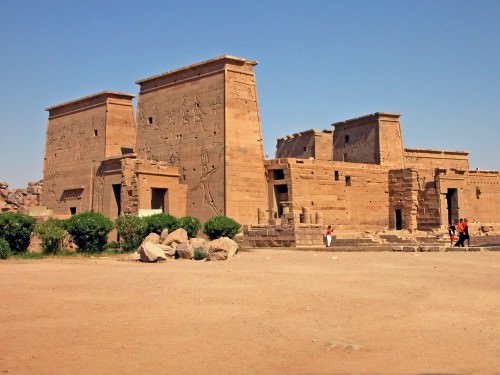
Philae Temple, Aswan
MYTHICAL ORIGIN
In mythology, Isis was born after the creation of the world. According to the most popular version of the myth, there was once only swirling chaotic waters and darkness in the universe until, one day, a mound rose from the seas with the god Atum standing upon it. Atum gazed out on the eternal nothingness and recognized he was lonely, and so mated with his own shadow to give birth to Shu (god of the air) and Tefnut (goddess of moisture). These two deities then left their father alone on the primordial mound (known as the ben-ben ) and went off to create the world.
Atum, alone on the hill in the midst of chaos, longed for his children and worried over their safety, and so he removed his eye and sent it out in search of them. This eye would later become one of the most iconic of all Egyptian images: the all-seeing eye (known as the Udjat eye, or Eye of Ra). Shu and Tefnut returned with the eye, having failed to create the world, and Atum was so happy to see them, he began to cry. As his tears fell on the fertile earth of the ben-ben, men and women sprang up.
These new fragile beings had nowhere to live, however, and so Shu and Tefnut mated and gave birth to Geb (the earth) and Nut (the sky). These two quickly fell in love and became inseparable; a situation Atum found intolerable as they were brother and sister. He pushed Nut high above Geb and fastened her there so the two lovers would be able to see each other but never touch again. Nut, however, was already pregnant by Geb and soon gave birth to five children: Osiris, Isis, Set, Nephthys, and Horus (known as Horus the Elder). These five gods were given the task of managing the realm of human affairs on the earth and, from them, came all the other gods of Egypt.
OSIRIS AND SET
Osiris married Isis and, as the first born, assumed rule as Lord of the Earth, with Isis as his queen and consort. The royal couple took their responsibilities so seriously that soon the humans had a paradise to live in with cool, rushing streams, plenty to eat, and a perfect climate. There was no injustice in the land, all women and men were equal, and everyone was at peace.Set was jealous of his brother's power and prestige, however, and so conceived a plan to get rid of him. He had a beautiful coffin made to Osiris' exact height, and then, threw a grand party where he presented this box and told the guests that whichever of them fit in it most perfectly could have it as a gift. When Osiris lay down in the coffin, Set slammed the lid on, fastened it shut, and threw it into the Nile, where it was carried away toward the sea.

Stele of Pay
Isis was distraught when she found her husband was missing and went searching for him all through Egypt without success.Osiris, meanwhile, had traveled out to sea, and eventually his coffin became lodged in a great tamarisk tree growing near Byblos in Phoenicia. The tree grew quickly around the coffin until it completely contained it. The king of Byblos, Malcander, came to the shore with his wife Astarte and admired the tree and the sweet scent which seemed to emanate from it. He ordered the tree cut down and brought to his palace as an ornamental pillar for the court, and there Osiris remained, trapped inside the coffin within the pillar, until he died.
RESURRECTION OF OSIRIS
Isis had meanwhile left Egypt in search of her husband and eventually came to Byblos, where she sat down by the shore and cried for her missing husband. The maidens who attended Astarte came to the shore to bathe, and Isis taught them how to care for their hair and plait it. When they returned to the palace, Astarte admired their new hair styles and the beautiful scent which seemed to float around them. She asked how they had thought of plaiting their hair, and the maidens told her of the mysterious woman by the shore of the sea. Astarte sent for Isis, who was disguised as an older woman, and asked her to tend to her children at court. Isis became particularly fond of the younger child, Dictys, and thought to make him immortal by burning away his mortal weakness in a holy fire.
When Astarte entered the room one night and found her nursemaid placing her son in the fire, she screamed, and Isis, startled, assumed her true form as the glorious goddess (these details share in the Greek myth of Demeter at the court of Eleusis ). Astarte and Malcander were terrified they would be killed and offered her any gifts she wanted. She requested only the pillar - which he swiftly granted to her. The image of this pillar containing the dead god who would return to life was represented later throughout Egyptian culture by the Djed symbol (a column with a broad base crossed by four parallel lines), which regularly appears in Egyptian iconography and architecture and stands for stability.
After leaving the court, Isis cut Osiris from the tree and carried his body back to Egypt where she hid him from Set in the swampy region of the Nile Delta. She left him to go gather herbs to make the a potion to return him to life, leaving her sister Nephthys to guard the body. While she was gone, Set learned of his brother's return and went out to find his body. He managed to get Nephthys to tell him where it was, and when he found it, he hacked it into pieces and scattered it across the land and into the Nile. When Isis returned, she was horrified but quickly composed herself and went to work finding the pieces of her murdered husband. With Nephthys' help, she recovered all of the body parts except the penis, which had been thrown into the Nile and eaten by a fish.
Isis still was able to revive Osiris and, once he was alive, she assumed the form of a kite and flew around him, drew the seed from his body into her own, and became pregnant with a son, Horus (thereby becoming a virgin mother). Even though Osiris now lived, he was incomplete and could no longer rule the land of the living. He withdrew into the afterlife where he became Lord and Judge of the Dead. Isis, fearing what Set might do to her son, hid Horus among the swamps of Egypt until he was grown. At that point, Horus emerged as a mighty warrior and battled Set for control of the world. In some versions of the story, Set is killed but, in most, he is defeated and driven from the land. The chaos Set had unleashed on the world was conquered by Horus, who restored order, and then ruled with his mother and Nephthys as consorts.
ISIS AND HARMONY
The myth expresses the central value of Egyptian culture, which was harmony (known as ma'at ) expressed in balance. The Egyptians believed that the gods depended on them to live in accordance with eternal values, and chief among these was ma'at, symbolized by the goddess of the same name who held the white feather of truth. If one lived in accordance with ma'at, one would enjoy a peaceful existence on earth and be rewarded in the afterlife, when one's heart was judged as lighter than the feather of truth, and afterwards be admitted to the paradise known as the Field of Reeds. This concept of balance is expressed repeatedly through images showing Isis and her twin sister Nephthys together where Isis is light, Nephthys dark;Isis is substantial, Nephthys ether and so on. Nephthys was never depicted as evil to Isis' good but was associated with death while Isis with life and so these two sister-deities symbolized cosmic balance.

The Goddess Isis
Isis personified ma'at in every story told about her. One of the most popular is known as Isis and the Seven Scorpions, which highlights Isis' kindness even to those who are not kind to her. The story relates how, when Horus was an infant and Isis was hiding him in the swamp lands from Set, seven scorpions kept her company. She would sometimes go out in the evenings for food, and the scorpions would form a kind of bodyguard around her. Three of them - Petet, Tjetet, and Matet - would go before her to make sure the way was safe and Set was not waiting in ambush, two were on either side of her - Mesetet and Mesetetef - and two brought up the rear - Tefen and Befen, who were the most fierce - in case Set came from behind.
Whenever she left the swamp, Isis would conceal her glory so she looked like a poor, older woman asking for alms in the town.One night, as she and her bodyguard entered the town, a very rich noblewoman looked down on them from her window and quickly slammed her door and locked it at their approach. The scorpions were angered at this affront to their mistress and decided to make the woman pay. The other six scorpions all surrendered their poison to Tefen who drew it up into his stinger and waited for the right moment. In the meantime, a poor peasant woman had seen the noblewoman refuse hospitality and, even though she had little, offered Isis and her scorpions a place under her roof for the night and a simple meal.
While Isis was eating with the young woman, Tefen snuck out of the house and crept beneath the door of the home of the noblewoman where he stung her young son. The boy fell down in a stupor, and the noblewoman grabbed him up and tried to revive him but could not. She ran into the streets crying for help, and Isis heard her. Even though the woman had refused her food and a place for the night, Isis forgave her. She did not want the boy to pay for his mother's insult. Isis took the child in her arms and called each of the scorpions by their secret name, thereby dominating them and neutralizing their power, and recited spells of great magic. The poison evaporated, leaving the child's body, and he revived. The noblewoman was so grateful and so ashamed of her earlier behavior, she offered all her wealth to Isis and the peasant woman.
To an ancient Egyptian hearing the tale, a number of lessons could be drawn: the importance of hospitality, kindness to strangers, forgiveness, refraining from acting in anger, and how the gods are just and kind no matter how undeserving a person might be. If a great goddess like Isis could forgive the insult of the noblewoman, people should likewise forgive each other and help each other. In another version of the story, the goddess Selket encouraged the scorpions to take revenge on the rich woman's son and then is ashamed when Isis forgives the woman and heals the boy. Selket afterwards became the protector of children against venomous bites; thus showing that even a goddess could learn kindness and compassion from the example of Isis.
ISIS OUTSIDE EGYPT
When Alexander the Great (356-323 BCE) conquered Egypt in 331 BCE his troops associated Isis with the popular Greek goddess Demeter. This association made her accessible to the people of Greece, who initiated their own rituals honoring the Egyptian goddess. After Alexander 's death, his general Ptolemy I Soter (367-283 BCE) took Egypt as his territory in the division of the spoils, and Hellenization of the Egyptian culture continued. Isis was then further associated with Demeter, especially through the similarities in their stories of Demeter's missing daughter Persephone and Isis' missing husband, and details from the two separate stories blended together. The Eleusinian Mysteries, the most important religious ritual in ancient Greece, elevated Demeter to the supreme position as keeper of the mysteries of life and death, and Isis eventually came to take on this same role.
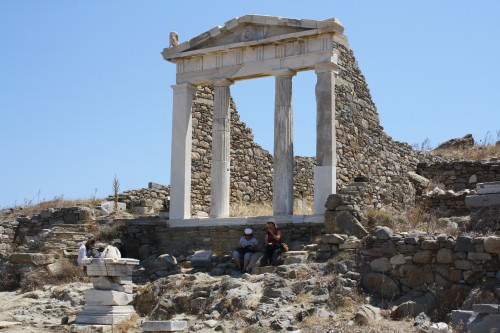
Temple of Isis, Delos
She traveled to Rome where she was known as Queen of Heaven and linked to Demeter's counterpart, Ceres, and eventually to Venus. Following the assassination of Julius Caesar in 44 BCE, and the resulting chaos of civil war, the Romans wanted to build a temple to honor Isis, not Venus, hoping for her protection and guidance through the dark times. Augustus Caesar(27 BCE-14 CE) refused to permit this, however, as he viewed the worship of Isis as a dangerous Egyptian belief which would weaken Rome. The gods of Rome were intimately tied to the affairs of state, and Augustus felt encouraging the worship of foreign gods would result in a breakdown of authority. He also simply had a long-standing hatred for Cleopatra VII and all things Egyptian, which no doubt played a part in his decision.
Augustus' objections were ignored by his successors, however, and under the reign of Caligula (37-41 CE) the worship of Isis in Rome was firmly established by the emperor through the Isiac Festival in her honor. The temple known as the Iseum was constructed in the reign of Vespasian and Domitian built another to honor the goddess during his own reign. Hadrian was particularly fond of Isis and decorated his villa with scenes from her stories. A temple of Isis has been found in Pompeii, and another in Great Britain at the Roman site of Londinium (modern London). Other temples were built throughout the Roman Empire from Germania through Gaul, and Hispania, and throughout Asia Minor. The cult of Isis became so popular outside of Egypt that, by the time Christianity was taking form, Isis was the pre-eminent deity of Europe and the Mediterranean associated with older goddesses such as Inanna / Ishtar, Aphrodite, and Sauska among others.
ISIS AND CHRISTIANITY
Isis dominated the religious sensibilities of the people at the same time that Christianity was taking form through the evangelical missions of St. Paul c. 42-62 CE. The concept of the Dying and Reviving God which had long been established through the Osiris myth was now made manifest in the figure of the son of God, Jesus the Christ. In time, epithets for Isis became those for the Virgin Mary such as "Mother of God" and "Queen of Heaven" as the new religion drew on the power of the older belief to establish itself. The worship of Isis was the most stubborn of pagan beliefs to rival the new faith and continued longer than any other.
In 380 CE, the Roman emperor Theodosius I decreed that all pagan temples be closed and pagan rites outlawed. The worship of Isis continued, however, and her temple at Philae in Egypt remained open long after others had been shut down, destroyed, dismantled for other projects, or turned into churches. Philae continued as a vital site dedicated to Isis until the emperor Justinian closed it, along with other important centers of learning and worship (such as the Academy of Plato ), in 529 CE. Philae is considered the last of the pagan temples of the ancient world to have stood against the rise of Christianity and once it was closed the worship of Isis was fully eclipsed by the new religion. In the same way as Osiris, Isis, and Horus had taken the place of Amon, Mut, and Khons in Egypt, the trinity of the Father, Son, and Holy Ghost replaced the Abydos Triad as the supreme deities of a new religious understanding.
Silver in Antiquity › Antique Origins
Definition and Origins
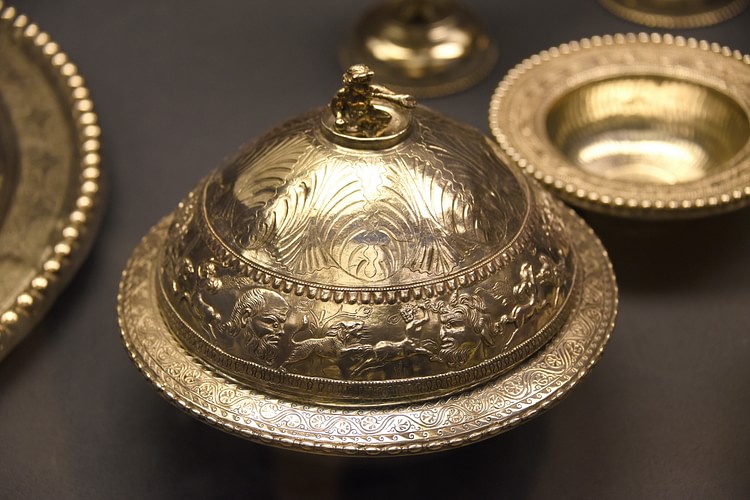
Silver had great value and aesthetic appeal in many ancient cultures where it was used to make jewellery, tableware, figurines, ritual objects and rough-cut pieces known as hacksilver which could be used in trade or to store wealth. The metal of choice to mint coinage for long periods, acquisition of silver mines in such places as Greece, Spain, Italy, and Anatolia was an important factor in many an ancient conflict. The metal was also found, amongst other places, in mines in ancient China, Korea, Japan, and South America where it was transformed into beautifully-crafted objects for elite use and to give as tribute and prestige gifts between states. Easily mined, worked, reusable, and brilliantly shiny, silver was one of the few truly international commodities which both connected and divided the ancient world.
PROPERTIES & MINING
Silver (Ag) is a soft metal which can be polished to produce an appealing lustre, two factors which made it ideal for ancient metalworkers to employ in their production of high-value goods. Silver was mined and smelted from ores such as lead carbonate (PbCO3) and galena (PbS). Ores usually contain less than 1% silver, but their abundance and lack of difficulty in smelting ensured ancient mining of the metal could be profitable, even from the Early Bronze Age. Smelting techniques improved over the centuries so that by the Classical period in Europe even low-grade ore could be exploited for the minute quantities of metal it contained. Indeed, smelting techniques made such progress that by Roman times it was possible to return to ore already treated (slag) in order to extract more silver from it. To strengthen the metal it was often alloyed with copper.
FOR THE INCAS SILVER WAS THOUGHT OF AS THE TEARS OF THE MOON.
Mining of silver in the Americas was largely done by digging vertical shafts into the ground. These tended to be shallow and so many were dug along an area of silver-bearing ore. Individual horizontal shafts were similarly short, only around one metre in length. Broken up using antler tools, the ore was crushed and smelted in clay crucibles. The Americas did not have bellows, and so the high temperatures needed for smelting were usually provided by several people blowing into the fire through tubes.As elsewhere, charcoal was used as the fuel source. Andean metalworkers were specialists at silver-plating and at producing alloys which mixed silver with gold, copper, and even platinum. Finished works were then often gilded or even painted.
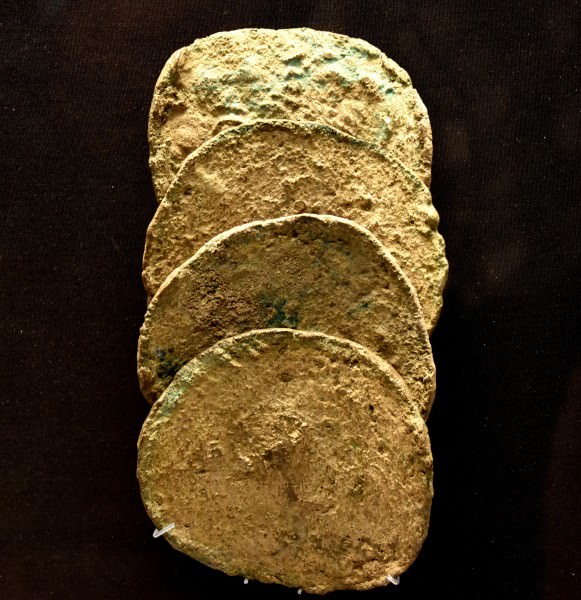
Silver Ingots from Syria
GEOGRAPHICAL AVAILABILITY
In Mesopotamia silver was used from the 4th millennium BCE. With no deposits in the area, silver was imported from Anatolia, Armenia, and Iran. Cities like Ugarit, Sumer, and Babylon used silver as a standard value measure with workers, for example, being paid in a specific weight of silver or its equivalent value in cereals. The Egyptians also valued silver and likewise acquired it through trade from Predynastic times, although silver archaeological finds are rarer than in other ancient cultures. This is perhaps because the Egyptians had their own sources of gold and only limited indigenous sources of silver.Certainly, silver was much closer in value to gold in ancient Egypt compared to other ancient cultures (1:2 instead of the more typical 1:13), and there were periods when it was considered even more valuable. In the Aegean, the Early Bronze Age cultures used silver which was mined from Attica (especially Laurion), the Cyclades, Thrace, and ancient Macedonia.
The Phoenicians, perhaps the greatest traders of them all, spread the use of silver even further across the ancient Mediterranean and channelled tons of it to western Asia, especially Assyria, mostly in the form of bullion (ingots, disks, and rings). The Phoenicians acquired such quantities that they earned an admonishing reference in the Bible : " Tyre heaped up silver" (Zechariah 9:2-3). To guarantee the weight and value, bars were stamped with official hallmarks. A Phoenician talent of silver weighed around 30 kilos and was worth 300 shekels. One silver shekel was worth 300 copper shekels and 227 shekels of tin. Gold was worth four times more than silver. Supply and demand affected the value of commodities just as they do today, and the oversupply of silver to the Near East caused a crash in the value of silver by the 6th century BCE.
Classical Athens benefitted from hitting a huge new seam on Mt. Pangaeus in Thrace, and both Carthage and Rome had a ready supply form Iberian mines and those on Sardinia. Indeed, the Romans worked some 40,000 slaves in the silver mines of Spain. The Etruscans did not go without, either, for they had access to silver in the north of their territory in Italy. By the later Roman period, as the empire expanded, silver was extracted from Britain, Germany, and the Balkans. Traded as coinage with peoples in India in exchange for spices and luxury goods, it was then converted back into bullion.
In the East, China's silver mines were exploited in the south from the 8th century CE, which led to the metal replacing silk as the primary method of bulk payment by merchants. In ancient Japan, silver was not extensively mined until the 16th century CE, but when it was, the metal became a handy method of payment with Portuguese traders who then spent it soon enough in their trade with China. So much silver went into the pockets of European traders - 20 tons a year - and the mines were worked out to such an extent that the Japanese government limited the silver taken out of the country from 1668 CE.
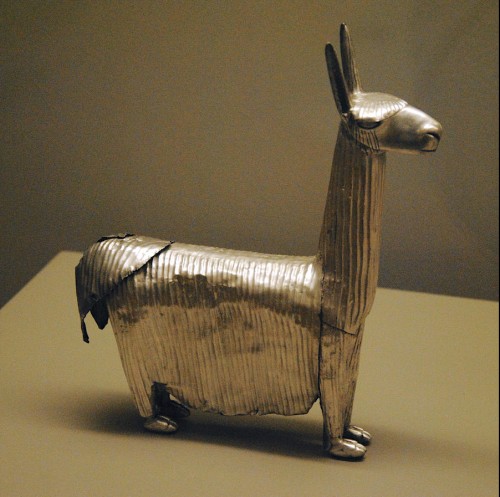
Inca Silver Alpaca
In the Americas, while the ancient Maya had plenty of gold, they had no silver of their own to speak of, but it was found in abundance further south, in the empires of the Incas and their predecessors. With plentiful supplies mined from northern South America (Colombia and Ecuador especially), the Moche, Wari, Lambayeque, and Chimu cultures all produced silverwork of the highest quality. For the Inca, just as gold was considered the sweat of the Sun, silver was thought of as the tears of the Moon. The rarity and prestige of the metal meant that it was restricted to use by the nobility; commoners had to make do with goods made from copper or bronze.
USES OF SILVER
Not as valuable as gold, silver was, nevertheless, used for much the same purposes but on a grander scale. Most ancient cultures benefitted from specialised craftsmen, often working for the royal household and given a dedicated area of the city to produce their shiny wonders. Jewellery, utensils, vessels, dishes, pepper castors, saucepans, figurines, masks, and decorative objects were made in silver. Silver, because of its high value, was widely used in objects related to religious rituals such as incense burners, relics containers, and votive offerings or dedications. Textiles were embroidered with silver thread, and items of clothing had pieces of silver sewn onto them. The metal was also widely used as an inlay material in such items as weapons, armour, furniture, and metal vessels.
HACKSILVER
Long before coins came along, silver in the form of ingots and rough cut pieces was a common method of payment for traders and states alike. This latter form, known as hacksilver (or hacksilber), was also used as a method to store wealth and was frequently buried, leading to spectacular archaeological finds of long-hidden hoards. Being roughly cut off from old jewellery, ingots, and basically anything made from pure silver, it was weighed each time a transaction was made, which often resulted in pieces being cut again and again to meet the exact weight required and, as a result, the pieces became ever smaller. The practice was common in the Near East, Egypt, and the ancient western Mediterranean up to the 4th century BCE when coinage largely replaced it. Hacksilver and silver ingots of no particular standardised weight were used in ancient India from the 8th to 7th century BCE. Small bent bars are typical, and judging by their differing weights, smaller pieces were probably cut from them before coinage became common.

The Taranto Hoard
Many hacksilver hoards include silver coins and so illustrate the gradual transition from one form of wealth storage to another.Spain, in particular, was an area where the habit of using hacksilver lingered on well into the 1st century BCE. With the demise of the Roman empire coinage production fell dramatically and hacksilver was, once again, the primary means to keep wealth and pay for goods. The Vikings, especially, were great savers of chopped up silver bits if the quantity of hoards discovered across central Europe, Britain, and Scandinavia are anything to go by.
SILVER COINAGE
One of the most common uses of silver throughout antiquity was as coinage. During the 6th century BCE, the first coins were minted in Lydia, which were made of electrum, a natural alloy of gold and silver, or of pure gold or pure silver. They were stamped with a design by the state as a mark of their authenticity and weight.
The first Greek coins appeared at Aegina c. 600 BCE (or even earlier), which were silver and used a turtle design as a symbol of the city's prosperity based on maritime trade. Athens and Corinth soon followed Aegina's lead. Heated discs of silver were hammered between two dies engraved with the designs. The birth of coinage in wider Greece, though, was not really an invention of convenience but a necessity, driven by the need to pay mercenary soldiers. These warriors required a convenient way to carry their wages, and the state needed a method of payment they could equally apply to everyone.
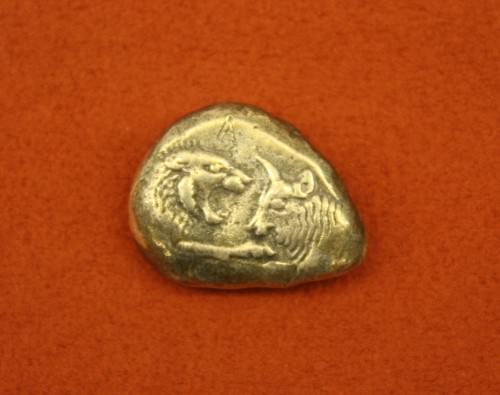
Lydian Silver Stater
Around 510 BCE Darius I introduced coinage in Persia, which included the silver shekel which weighed around 5.5 grammes.The master traders the Phoenicians long preferred the universal acceptability of silver bullion wherever their trade tentacles reached but, eventually, they too succumbed to progress. The first Phoenician coins were minted at Kition c. 500 BCE, then at Byblos c. 470 BCE. Other cities soon followed suit, Sidon and Tyre introducing silver coins around 450 BCE.
Coinage solved one problem but posed another, raising the interesting question of metal purity. The ancients were not aware of the concept of elements and their inherent properties, but smelters, through the necessity of creating coinage that was of a standardised weight, did manage to reach a purity of silver of around 98%. Silver coins were of relatively high value, perhaps equal to one week's work for most citizens. Only in the Hellenistic Period did smaller denominations become more widespread.
The first Roman silver coins were produced from the early 3rd century BCE and resembled contemporary Greek coins. C. 211 BCE a whole new coinage system was introduced. Appearing for the first time was the silver denarius (pl. denarii), a coin that would be the principal silver coin of Rome until the 3rd century CE. Following the acquisition of the silver mines in Macedonia from 167 BCE, there was a huge boom in silver coins from 157 BCE. Gradually, as emperors spent more frivolously and wars drained the state coffers, silver coins went from almost pure to 70% then 50% and on down until they reached an all-time low of just 2% silver content.
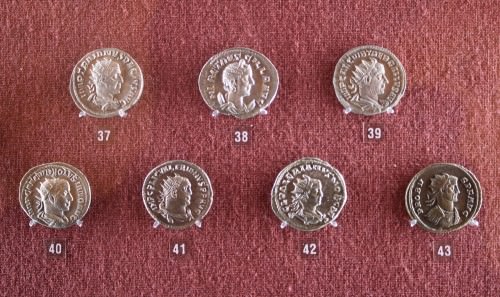
Roman Empire Silver Coins
Chinese coins, with their distinctive square central hole, were first produced in the second half of the first millennia BCE, but they were always made of copper. Coinage arrived in ancient India around the 6th century BCE. The ancient Americas had no coinage, but silver, like other precious materials such as gold and textiles, was used for trading purposes. Silver was highly valued and goods made from it were used as gifts and tribute, but their specific value depended on each item and the context in which it was given.
One final form of currency, in use in Korea from the 12th to 14th century CE, was the unbyong silver vase, stamped by the state and given an official rate of exchange with staple commodities such as rice; it was shaped like the peninsula of Korea.Unfortunately, no examples survive, but we do know from a 1282 CE law that the value of one unbyong was fixed at between 2,700 and 3,400 litres of rice. Despite their impracticality for smaller transactions, the vases continued to be used over the next two centuries, until King Chungyol permitted rough or broken pieces of silver to be used instead at the end of the 13th century CE.
LICENSE:
Article based on information obtained from these sources:with permission from the Website Ancient History Encyclopedia
Content is available under License Creative Commons: Attribution-NonCommercial-ShareAlike 3.0 Unported. CC-BY-NC-SA License